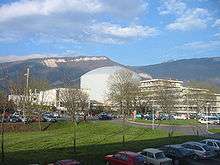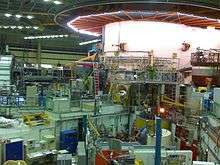Institut Laue–Langevin
Coordinates: 45°12′22″N 5°41′34″E / 45.206239°N 5.692774°E


The Institut Laue–Langevin (ILL) is an internationally financed scientific facility, situated on the Polygone Scientifique in Grenoble, France. It is one of the world centres for research using neutrons. Founded in 1967 and honouring the physicists Max von Laue and Paul Langevin, the ILL provides one of the most intense neutron sources in the world and the most intense continuous neutron flux in the world in the moderator region: 1.5×1015 neutrons per second per cm2, with a thermal power of 58.3 MW.
The ILL neutron scattering facilities provide an indispensable analytical tool for the analysis of the structure of novel conducting and magnetic materials for future electronic devices, the measurement of stresses in mechanical materials, and investigations into how complex molecular assemblies behave, particularly in a biological environment. The ILL also tackles questions relating to the fundamental properties of matter.
History

The institute was founded by France and Germany, with the United Kingdom becoming the third major partner in 1973. These partner states provide, through Research Councils, the bulk of its funding. Ten other countries have since become partners. Scientists of institutions in the member states may apply to use the ILL facilities, and may invite scientists from other countries to participate. Experimental time is allocated by a scientific council involving ILL users. The use of the facility and travel costs for researchers are paid for by the institute. Commercial use, for which a fee is charged, is not subject to the scientific council review process. Over 750 experiments are completed every year, in fields including magnetism, superconductivity, materials engineering, and the study of liquids, colloids and biological substances.
The high-flux research reactor produces neutrons through fission in a specially designed, compact-core fuel element. Neutron moderators cool the neutrons to useful wavelengths, which are then directed at a suite of instruments and used to probe the structure and behaviour of many forms of matter by elastic and inelastic neutron scattering, and to probe the fundamental physical properties of the neutron. Nothing goes to waste: Fission products and gamma rays produced by nuclear reactions in the reactor core are also used by specialised instruments, which forms an important part of the instrument suite.
An ambitious modernisation programme was launched in 2000, through the design of new neutron infrastructure and the introduction of new instruments and instrument upgrades. The first phase has already resulted in 17-fold gains in performance. The second phase has started in 2008, it comprises the building of 5 new instruments, the upgrade of 4 others, and the installation of 3 new neutron guides.
EPN Science Campus
| Science with Neutrons |
|---|
 |
| Foundations |
| Neutron scattering |
| Other applications |
|
| Infrastructure |
|
| Neutron facilities |
The ILL shares its site, the 'epn science campus',[1] with other institutions including the European Synchrotron Radiation Facility (ESRF) and the European Molecular Biology Laboratory (EMBL) and the Unit for Viral Host Cell Interactions (UVHCI).
Members
The ILL is governed by its Associates, the founding countries:[2]
- France, Germany and United Kingdom
in association with its Scientific Member countries (listed below by chronological order of accession):
- Spain, Switzerland, Austria, Italy, Czech Republic, Sweden, Hungary, Belgium, Slovakia, Poland, India and Denmark.
Applications research
In summer 2016, using an imaging technique neutron radiation, the facilities of the Institut Laue–Langevin demonstrate that a molecule called ectoine is used by Halomonas titanicae near the wreck of RMS Titanic to survive the osmotic pressure that causes salt water on their membranes. [3]
Awards and recognitions
The physicist Duncan Haldane who worked at the institute from 1977 to 1981 received the Nobel Prize in Physics in 2016 with Michael Kosterlitz and David J. Thouless for their work on the transitions of topological phases in the material.[4][5]
Rudolf Mossbauer, Nobel Prize in Physics in 1961, succeed to Heinz Maier-Leibnitz in 1972 as the director of the institute.
See also
References
- ↑ epn-campus.eu
- ↑ "An international partnership for science".
- ↑ laboratoryequipment.com, September 6, 2016, Extremophile Bacteria’ Will Eat Away Wreck of the Titanic by 2030.
- ↑ nytimes October 4, 2016, 3 Who Studied Unusual States of Matter Win Nobel Prize in Physics.
- ↑ ill.eu October 4, 2016, Congratulations to the 2016 Physics Nobel Prize laureates !
Sources
- The 2015 ILL annual report
- medicalxpress.com Alzheimer's disease markers could be identified through protein water mobility